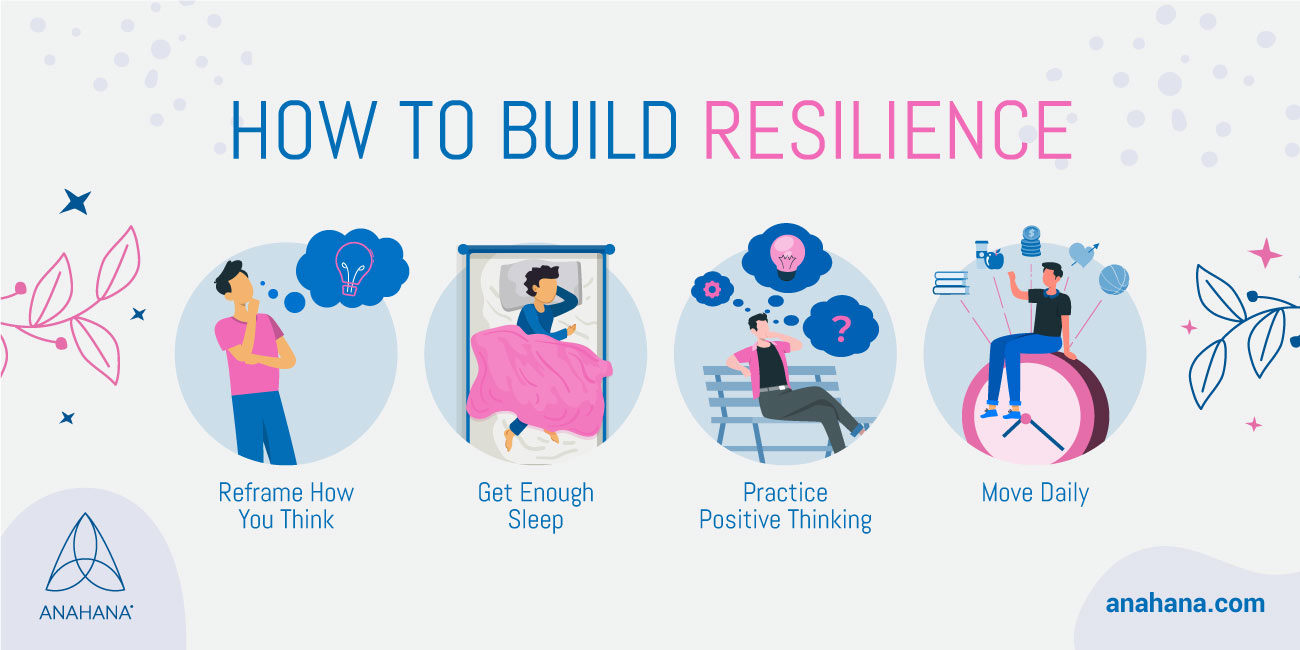Imposter Syndrome
If an individual is experiencing unfounded feelings of incompetence and self-doubt, it could be an indication of imposter syndrome.
The word resilience is derived from the Latin verb resilire, meaning to recoil or jump back. According to the American Psychological Association (APA), resilience is the ability of individuals to adapt or overcome adversity.
 The danger of the human condition is that humans can quickly create or exaggerate stressors in their minds, making it harder to demonstrate resilience. Therefore, it is critical to understand that resilience is a dynamic process that builds over time through various experiences, personal skills and social interactions.
The danger of the human condition is that humans can quickly create or exaggerate stressors in their minds, making it harder to demonstrate resilience. Therefore, it is critical to understand that resilience is a dynamic process that builds over time through various experiences, personal skills and social interactions.
Resilience does not mean individuals cannot experience emotional suffering, stress, or pain, but resilient people can better handle adversity. They understand that difficult emotions and adversity are not long-lasting and can harness their inner strength to regulate emotions and deal with the situation.
Individuals who lack resilience often feel overwhelmed and helpless and rely on unhealthy coping strategies, including isolation, avoidance and self-medication. Other unhealthy coping mechanisms include risky behaviors, eating disorders and substance use.
While there is no standardized measure for resilience, various scales can measure resilience in the most basic form: an individual’s capability to adapt to situations. Resilience can be measured using the brief resilience scale, which consists of six statements that measure the individual’s ability to bounce back or approach personal problems.
 Every human being goes through a difficult position in life, whether that means having experienced personal, social, or environmental issues. Resilience is important because it gives individuals the emotional, mental strength and behavioral flexibility to deal with life’s challenges and stressors.
Every human being goes through a difficult position in life, whether that means having experienced personal, social, or environmental issues. Resilience is important because it gives individuals the emotional, mental strength and behavioral flexibility to deal with life’s challenges and stressors.
Resilient people remain hopeful about the future and adapt and view new experiences with less anxiety and negative emotions. Furthermore, it allows individuals to maintain balance during stressful periods.
How individuals deal with problems significantly affects the immediate outcome and has long-term psychological consequences. Therefore, building resilience will enhance an individual’s well-being, long-term health and ability to adapt to personal challenges.
The term resilience was coined by psychologist Emmy E. Werner in 1973, who conducted a longitudinal study on a cohort of Hawaiian children from low socioeconomic backgrounds. These children grew up with parents who had a mental illness or alcoholism.
Werner found that two-thirds of children displayed destructive behaviors in later teens, including chronic unemployment and substance use. In contrast, one-third of the children did not exhibit maladaptive behaviors. Instead, Werner described these children as resilient because they used mental processes and behaviors to protect themselves from negative emotions and stressors.
Other studies in the 1980s evaluated resilience in children with schizophrenic parents. They discovered that compared to children with healthy parents, there was a detrimental impact on the children’s development who lived with schizophrenic parents.
However, some children of schizophrenic parents were academically and emotionally competent, allowing researchers to understand responses to adversity. Other sociocultural, cognitive-behavioral, and biomedical paradigms have varying perspectives on resilience.
However, most psychologists agree that resilience involves two key concepts: positive adaptation and adversity. Since the start of research on resilience, investigators have studied resilience and the protective factors that explain individuals’ adaptation to adverse situations, including poverty, maltreatment, or catastrophic life events.
The resilience theory is a psychological model studied across various fields, including human development, change management, and psychiatry. It explains what resilience is and how individuals overcome adversities.
According to the theory, tragic events such as war, natural disasters, pandemics, mass shootings, and terrorist attacks are inevitable and shared realities. Additionally, adversity can take the form of personal crises, including job loss, financial instability, abuse, loss of a loved one, and illness. Thus, the resilience theory emphasizes community and individual resilience, as resilient people can remain calm and recover from a major loss, setback, or traumatic event.
It states that resilience is a dynamic trait, not fixed or constant. For example, individuals might demonstrate resilience when faced with a certain challenge or stressor but struggle with facing challenges or adapting when dealing with another adversity.
Resilience theory states that resilient individuals are affected by risks, loss, change, and adversity. Still, they must learn to work through and cope with these experiences.
 According to resilience theory, the key factors that play a role in resilience include communication skills, problem-solving skills, social support, coping skills, a sense of control, and emotional regulation. Developing resilience involves a multitude of factors, including both internal and external resources and strengths. Some factors that allow individuals to develop resilience are:
According to resilience theory, the key factors that play a role in resilience include communication skills, problem-solving skills, social support, coping skills, a sense of control, and emotional regulation. Developing resilience involves a multitude of factors, including both internal and external resources and strengths. Some factors that allow individuals to develop resilience are:
Other studies have found six main predictors of resilience: flexibility, adaptability, balance, perspective, positive personality, and social support. Other protective factors that moderate adverse effects of environmental risks of stressful situations include external support, personal attributes, family, and community.
Demographics, including gender, SES, and resources, can also predict resilience. Research demonstrates a lower likelihood of resilience in women following a natural disaster than in men.
Certain aspects of mindfulness, spirituality, and religion can also hinder or promote psychological virtues contributing to resilience. A combination of adaptive skill building, supportive relationships, and positive experiences are the basis of resilience.
 While the word resilience is commonly used to represent overall coping and adaptability in individuals, it can be broken down into various categories. There are different types of resilience, each of which may influence a person’s ability to cope with stress. The four types of resilience are psychological, emotional, physical, and community.
While the word resilience is commonly used to represent overall coping and adaptability in individuals, it can be broken down into various categories. There are different types of resilience, each of which may influence a person’s ability to cope with stress. The four types of resilience are psychological, emotional, physical, and community.
Psychological or mental resilience is an individual’s ability and mental fortitude to use their strengths and skills to mentally adapt to or cope with challenges, uncertainty, and adversities. Individuals with psychological resilience can remain focused and calm and move on from life’s challenges or crises without long-term consequences, such as anxiety and psychological distress.
Emotional resilience is how individuals deal with stress as individuals respond to change and situations differently. Certain events may trigger emotions in some individuals and not others. Emotionally resilient individuals can recognize and understand their emotions. They use internal and external resources to manage stressors and their feelings optimistically and positively.
Physical resilience refers to how the body recovers from and deals with changes from physical demands, injuries, and medical issues. It affects an individual’s strength and stamina and plays a vital role in long-term health, including how people age and respond to physical stress, illnesses, and accidents. Social connections, resting time, healthy lifestyle choices, and enjoyable activities contribute to physical resilience.
Community resilience is the ability of groups to recover and respond to adverse situations that affect groups, such as natural disasters, terrorist attacks, violence, economic hardships, and mass shootings. A most recent situation testing community resilience is the COVID-19 pandemic.
In children, resilience is especially evident when a child’s health and development lean toward positive outcomes, even when there is a load of factors on the negative outcome side. Over time, the cumulative impact of coping skills and positive experiences can make it easier to achieve positive outcomes.
Ken Ginsburg, MD, a pediatrician specializing in adolescent medicine in Philadelphia, developed the 7Cs model of resilience to help children build the skills to be happier and have better mental health.
The model is based on two fundamental points, including how children live up to their expectations and their need for supportive adults who model resilience for the children to adapt to challenges.
The 7Cs include competence, contribution, connection, character, coping, and control.
Competence requires individuals to possess the skills to feel competent enough to deal with stressful situations. Rooted in competence is the skill of confidence, an individual’s belief in their abilities. Identifying individual strengths can enhance and motivate individuals to overcome challenges.
Coping refers to leveraging personal strengths, including social and stress reduction skills, to be better prepared to overcome adversities and challenges and improve mental health. In addition to coping, individuals who control their decisions and actions are more likely to bounce back from hardships and enjoy a strong character or sense of self-worth and confidence.
Connections further enhance resilience in individuals through close ties with family, friends, and community groups, fostering security and belonging. Lastly, if individuals, especially young adults, experience personally contributing to the world, it will increase their willingness to make decisions and choices that improve the world, enhancing their character, competence, and sense of connection.
The 7Cs are especially valuable to help children understand their values and choices when making decisions and are integral and interconnected components that constitute resilience. The interaction between biological and environmental factors influences a child’s ability to overcome threats to healthy development and build resilience at a young age.
Resilience in children results from a combination of settings, including the classroom, community, and family.
Children in the classroom have been characterized using the locus of control. An internal locus of control, a greater sense of control, and high expectations in children are linked to greater resilience.
The community also plays a significant role in fostering resilience in children. A cohesive and supportive community involves social organizations, connections and good communication that promote healthy development. Meaningful community building and participation are opportunities for resilience building.
Family environments that are supportive, stable, and caring encourage the child’s participation in family life. Most resilient children have a strong bond with at least one parent or adult in their family that delivers a quality and competent level of parenting to children, helping them build resilience in life.
The child's environment, whether in the classroom, community or family, influences their ability to understand and adapt resilience. As children cultivate resilience early on, they adapt well to adversity, threats and challenges as adults.
Research suggests that resilience, like trauma, is influenced by epigenetic modifications, including higher DNA methylation of growth factors in specific regions of the brain, promoting stress resilience.
Furthermore, the hypothalamic-pituitary-adrenal axis mediates the relationship between social support and stress resilience via oxytocin. Oxytocin increases an individual’s resilience to subsequent traumatic events. Therefore, resilience is a bio-psychological concept that can help understand the mechanisms predicting long-term well-being and health.
Research shows that resilience and a sense of self-worth in overcoming challenging life experiences can help individuals confront chronic illnesses such as rheumatoid arthritis, cancer, type 2 diabetes, anxiety, and depression.
Resilience can protect individuals from various mental health conditions, including anxiety and depression while offsetting factors that increase the risk of certain mental health conditions. For example, two neurotransmitters that buffer stress within the brain are endogenous opioids and dopamine.
Evidence shows that opioid antagonists and dopamine increase the stress response in animals and humans. The reward system, mediated by dopamine, also lowers negative reactivity to stress in animal and human brains.
 Resilience is not part of an individual’s personality, but individuals can become more resilient by engaging in mindful thinking and reflection. As part of cognitive behavioral therapy, building resilience means mindfully reflecting on and altering negative behaviors and thought processes. The first step is to engage in positive self-talk and identify positive and negative emotions and behavior patterns.
Resilience is not part of an individual’s personality, but individuals can become more resilient by engaging in mindful thinking and reflection. As part of cognitive behavioral therapy, building resilience means mindfully reflecting on and altering negative behaviors and thought processes. The first step is to engage in positive self-talk and identify positive and negative emotions and behavior patterns.
The second step is to harness their inner strength and adapt coping skills that tend to their needs, helping them lower stress levels.
Common coping mechanisms include exercise, physical activity, deep breathing, improving sleep hygiene, getting enough sleep, and doing activities or hobbies individuals enjoy that can help deal with challenging and stressful situations. Making these activities a part of the daily routine can help achieve resilience.
Fostering resilience takes time and practice. However, it can be challenging for some individuals to understand where to start and what coping skills to utilize. For example, consulting a mental health professional can guide individuals to improve mental well-being and resilience.
Individuals must build skills to develop resilience and endure hardships because resilience is the outcome of successfully adapting to difficult experiences by adjusting to external and internal demands. There are many ways to encourage resilience in individuals, and words can be incredibly empowering. Individuals must focus on the present and harness positive emotions and strength to build resilience and recover from a significant setback in the future.

If an individual is experiencing unfounded feelings of incompetence and self-doubt, it could be an indication of imposter syndrome.

Learn more about human thinking patterns and the concept of synchronicity. Understand the experience of synchronicity and how to interpret...

Uncovering the inner self and understanding the shadow aspects of it is a powerful practice that can lead to personal growth. Learn more about...